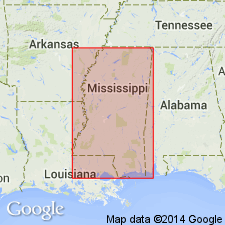
- Usage in publication:
-
- Rodessa Formation
- Modifications:
-
- Overview
- AAPG geologic province:
-
- Mid-Gulf Coast basin
Summary:
Rodessa Formation consists primarily of land-derived detrital material. In Raymond Field, unit is a 600 to 700-ft section. The lower Rodessa consists of 145 to 275 ft of alternating sands and shales. Sands are 20 to 60 ft thick, white to gray, fine- to medium-grained, and moderately well cemented. The middle Rodessa is 125- to 200 ft thick and consists predominantly of shales and mudstones. Upper Rodessa is referred to in this report as Rodessa Consolidated and contains three distinct sands. Overlies the Pine Island Formation and underlies the Ferry Lake Formation. Age is Early Cretaceous (Comanchean).
Source: GNU records (USGS DDS-6; Reston GNULEX).
For more information, please contact Nancy Stamm, Geologic Names Committee Secretary.
Asterisk (*) indicates published by U.S. Geological Survey authors.
"No current usage" (†) implies that a name has been abandoned or has fallen into disuse. Former usage and, if known, replacement name given in parentheses ( ).
Slash (/) indicates name conflicts with nomenclatural guidelines (CSN, 1933; ACSN, 1961, 1970; NACSN, 1983, 2005, 2021). May be explained within brackets ([ ]).

